For the previous three years we have been testing the practice of growing vegetables and herbs in polycultures (or what is known as guilds within permaculture circles). We have been using our home garden for these tests and recording the inputs and outputs from the growing seasons. Our aim is to discover whether or not growing in polycultures offers benefits over conventional methods of growing, and to see to what degree we can obtain good yields of nutrient dense food whilst providing habitat for garden wildlife.
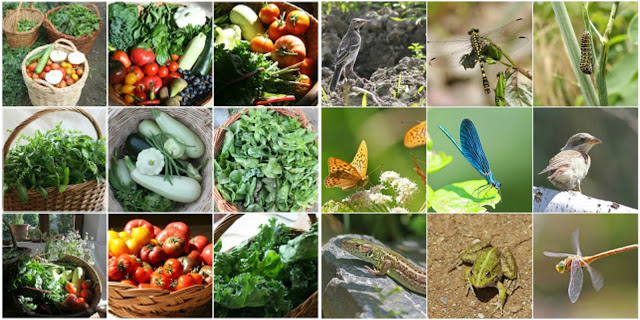
Garden produce and wildlife
What follows is a description of the garden layout and planting scheme, an overview of our cultivation practices, the results from year three of the study, our record keeping methods, and some notes and observations from this year.
If you would like to see a summary of results from previous years click here.
Last year we started a scaled up version of this study looking at polyculture growing for a market garden. The results from year 2 will be coming soon. You can read more about that study here
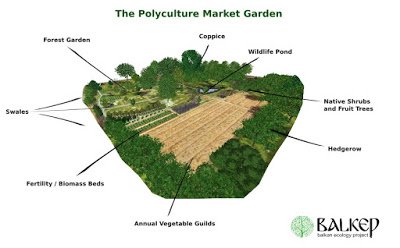
The Polyculture Market Garden
Garden Overview
Climate: Continental Temperate
Latitude: 42°
Elevation: 580 m
Average Annual Rainfall: 588.5 mm
Co-ordinates:42°42′N 25°23′E
The Polyculture beds on a mid spring morning
Garden Layout
Garden area: 66.5m2
Cultivated beds area: 36m2
Paths: 30.5m2
Path and Bed Layout
The Polyculture Planting Scheme
Below is a typical representation of the polyculture planting scheme within a bed.
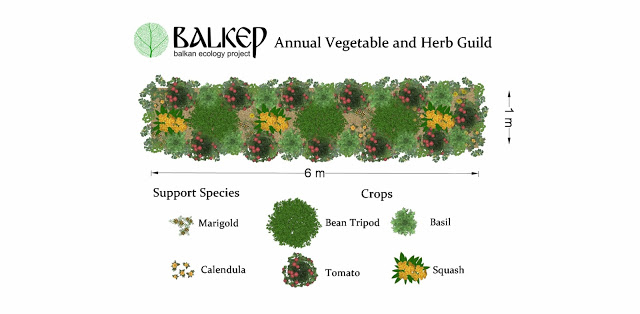
Vegetable Guild/Polyculture
In 2016 the following plants were grown in the 6 beds (36m2)
11 x Tomato - Solanum lycopersicum 'Black Krim'
11 x Tomato - Solanum lycopersicum 'Tigerealla'
11 x Tomato - Solanum lycopersicum 'Mixed Saved Seed'
11 x Tomato - Solanum lycopersicum 'Rozova Magia'
11 x Tomato - Solanum lycopersicum 'Anna Russian'
11 x Tomato - Solanum lycopersicum 'Ukranian Purple'
66 x Basil - Ocimum basilcium 'Sweet Genovese'
27 x French Beans - Phaseolus vulgaris 'Cobra'
27 x French Beans - Phaseolus vulgaris 'Local'
2 x Courgette - Cucurbita pepo 'Black Beauty'
4 x Yellow Bush Scallops - Cucurbita pepo
6 x Butternut Squash - Cucurbita pepo 'Waltham Butternut'
4 x Swiss Chard - Beta vulgaris subsp. cicla ' Rainbow Chard '
4 x Sunflower - Helianthus annuus
12 x African Marigold - Tagetes erecta
12 x French Marigold - Tagetes patula
6 x Pot Marigold - Calendula officinalis
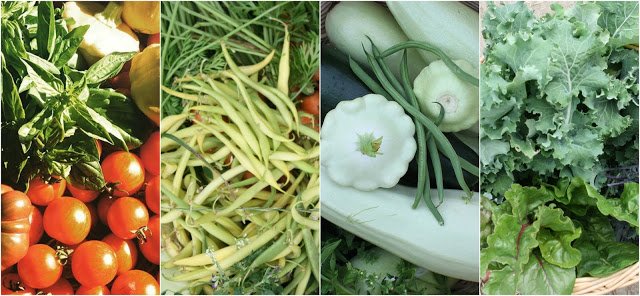
Polyculture Produce
The table below shows the floral species composition of each bed including the different cultivars and the dates that the plants were sown or planted. Beans, courgettes and winter squash were sown directly into the beds, tomatoes, basil, chard and marigolds were grown from seed indoors reared to approx 15 cm tall and planted outside around mid spring. Sunflowers and pot marigolds are self seeded.
Other plants such as volunteer nasturtiums were also growing within the beds. The yield of these plants are not considered in these records. Also not included are the native wild plants that are encouraged to grow around the perimeter of each bed. Many of these plants provide excellent fodder for our chickens and rabbits as well as mulch material when chopped and dropped on the beds.
click here to see the table: http://balkanecologyproject.blogspot.bg/2016/11/polyculture-trials-2016-home-garden.html
Polyculture Cultivation Practices
In the early spring when the temperatures are warm enough for the chickens to be outside during the night, we place a 1 m x 3 m bottomless chicken coop with 8 - 10 hens inside onto one half of a bed. The chickens will live there for 3 or 4 days and each day we throw them in kitchen scraps, grain and weeds. The chickens relentlessly scratch among the soil and mulch picking off the eggs of slugs and larvae as well as pupae of various arthropods. They also forage for seeds in the soil and thereby reduce the emergence of undesirable plants in the bed. The chicken's scratching mixes up the organic matter we throw in daily and the birds contribute a valuable supply of droppings as they go.
The chicken run 1.3 x 3 m light frame bottomless coop
After 3 or 4 days we move the chickens onto the next half of the bed and the process repeats. The area the chickens have just moved from is forked over, soaked well (or we wait for a rain) and usually 20 L of compost per 1.5 m length are applied i.e 80 L per bed). A 20 cm layer of Straw mulch (approx 3/4 of a bale) is then laid to cover the surface. The mulch provides good habitat for toads and lizards (in the spring, summer and autumn) which are well positioned to pick off any slugs that venture in for the young seedlings.
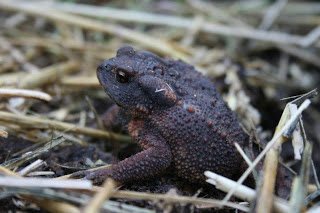
Common Toad clearing out the slugs before the plants go in
Once mulched the stakes for tomatoes and beans are put into position. Large reliable germinating seeds such as beans and squash are sown directly into the beds by pulling back the mulch, making a small nest adding 3 handfuls for potting mix (50% compost 50% river sand) and sowing the seeds directly into the mix. All other plants are reared in pots and planted into the beds when approx 15 cm tall and when the weather is suitable. Any weed plants that grow around the edge of the beds are cut back before they set seed and used as additional mulch throughout the year. Weeds growing within the bed are treated the same way. Note that weeds are not uprooted only cut to ground level. The roots are allowed to decay in the ground or left to regrow until they are again ready to "chop and drop".
Around July the vegetable and herb plants are all well established with little room for weeds to establish. The attention the beds require after July is mainly irrigating and harvesting until October.
The polyculture in the summer
When the last of the harvest is out of the beds, the stakes are removed and if warm enough the chickens are brought in for another 3 or 4 days to pick through the vegetation. None of the plant material is removed from the beds. What the chickens leave behind is cut into small pieces and applied to the surface as an overwinter mulch. In November garlic is planted in some of the beds. November sown garlic will normally mature in June, however we use the small bulbs that are not worth planting as main crop garlic and harvest them in March like spring onions before the chickens go on, providing a deliciously fresh treat in early spring.
Inferior Garlic bulbs planted 10 cm apart 5 rows per bed for a spring harvest
Soil Analysis
Each spring and autumn we obtain a soil sample and send it to NAAS of the Ministry of Agriculture and Food. We can see from the samples rising levels of essential plant nutrients and check our pH levels are within the optimal range for vegetable production.
Mineral Analysis from 01.04.2016

Mineral Analysis from 01.11.2016

Year 3 Results in Summary
This year we harvested 168 kg of vegetables including tomatoes, basil, beans, garlic, winter & summer squash, chard and sunflower heads, a 51 kg decrease on last year's total.
The time spent on this garden, including propagating all the plants from seed, preparing the beds, tending the plants, irrigating and harvesting amounted to 57 hrs and 20 mins from March - October. We used 480 L less compost this season than last season.
Results: Inputs and Outputs
You can find the full spreadsheet here.
click here to see the table: http://balkanecologyproject.blogspot.bg/2016/11/polyculture-trials-2016-home-garden.html
Table summarizing input and outputs from October 31st 2015 - October 31st 2016
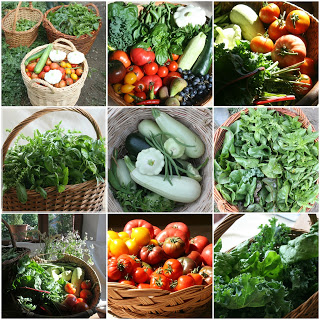
Garden Produce
All produce was weighed directly after harvest and unless otherwise stated, all of the produce recorded was in excellent condition and fit for market. Produce not fit for market was composted or fed to our animals and is not included in these records.
Record Keeping Methods
The tasks were predominantly carried out by one person, either myself, my partner Sophie or one of our boys Dylan and Archie. A timer is started just before the task starts and stopped when the task is complete. On a few occasions two people were working on tasks at the same time, namely erecting the stakes and planting the garlic. These occasions are recorded in the management sheet of the record keeping spreadsheet 2015 (in the "Notes" row).
In 2015 we established base times for garden tasks that are carried out each year and we extrapolate from this results for future records. Some tasks differ in quantity each year such as irrigation, mowing and harvesting and we account for these separately.
Irrigation
Our irrigation system is unique to our garden in that we flood irrigate using a mountain stream, however I estimate the irrigation needs of the polyculture to be 20 L per m² i,e 120 L per bed or 720 L for the entire garden applied once a week in the absence of rain (normally July- September). The time taken to apply 120 L per bed is estimated at 10 minutes so that's 60 mins per irrigation session. This year we experienced a very dry summer with a period of 13 weeks without significant rain. During this period, irrigation was practiced once per week.
Mowing
The time for mowing is estimated to be 10 minutes. During dry seasons less mowing is required whereas during wet seasons more mowing is required. This year we mowed the pathways seven times.
Harvesting
Harvesting times are recorded along with other garden tasks such as tying tomatoes and weeding. so we don't have a base for this task. For this year's results we used last year's figures, but it would actually be less as the total produced harvested is 51 kg less this year. A harvest base time is required for future records.
Notes and Observations from 2016
Farm Ducks were free ranging in the garden from July - mid October and often foraging in the straw. This breed of duck (some type of mallard breed) caused little notable damage in the garden but probably made it less likely for toads and lizards to hunt in the straw.
Ducks in the beds
The decrease in production this year may be attributed to the below:
We did not add the usual 480 L of compost this year as the soil results showed ample nutrients for vegetable production.
A cold and wet April and May meant that many squash and beans did not germinate. This resulted in less production from beans and squash than would be expected. Next year we will be growing these plants in starter trays and planting out when the weather conditions are favorable.
The market value of the produce is estimated based on average market prices from the food coop Trustika. It is not what we actually sold the food for, as much of the food from this garden was consumed by us or preserved.
Our low expenses are attributable to the fact we grow our own plants from seed, make composts and sowing mediums, grow summer and autumn mulch and save seeds from plants that do not readily crossbreed such as tomatoes, basil, marigolds and beans. We also provide our own support materials (tomato stakes and bean poles). Time taken to make composts and harvest support stakes are not included in the records.
Improvements for Future Studies
Biodiversity Study
It's our goal to build productive ecosystems that provide for a large diversity of organisms as well as us. We believe our gardens achieve this but currently have no way of quantifying/qualifying this. We'd like to develop a method of biodiversity measurement that can be used and believe that invertebrate diversity would be a great place to start. The Plants for Bugs experiment carried out by a team of entomologists at RHS Wisley would work well. During this study invertebrate samples were taken on five occasions throughout the year and recorded. The samples are gathered using pitfall and baited refuge traps for ground fauna, and direct observation of flying insect visitors and those settled on the plants.
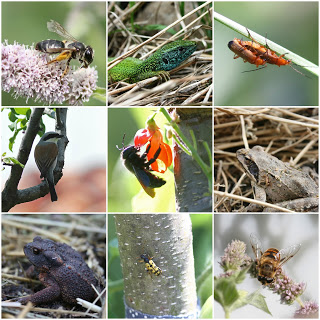
Our goal is to create garden ecosystems that are productive for man and for nature.
Photographs taken from the garden.by Paul Alfrey and Peter Alfrey.
We are currently seeking collaboration with entomologists that could assist us with this part of the study. If you or someone you know is interested in this please do get in touch.
Sharing, Feedback and Collaboration
We have our record keeping spreadsheets on Google Drive. These spreadsheets include all of the data entries and task descriptions. You can find the spreadsheet here. (note there are multiple sheets that can be accessed from the blue tabs running along the top of the sheet).
You are welcome to a copy of the spreadsheet format that you can use for your own purposes. Just drop us an email or leave a comment below with your contact details and we will send it over to you.
See here for the results of our polyculture studies from 2014 - 2016
Hi! I am a robot. I just upvoted you! I found similar content that readers might be interested in:
https://permaculturenews.org/2016/12/14/polyculture-trials-2016-home-garden-records/
Downvoting a post can decrease pending rewards and make it less visible. Common reasons:
Submit